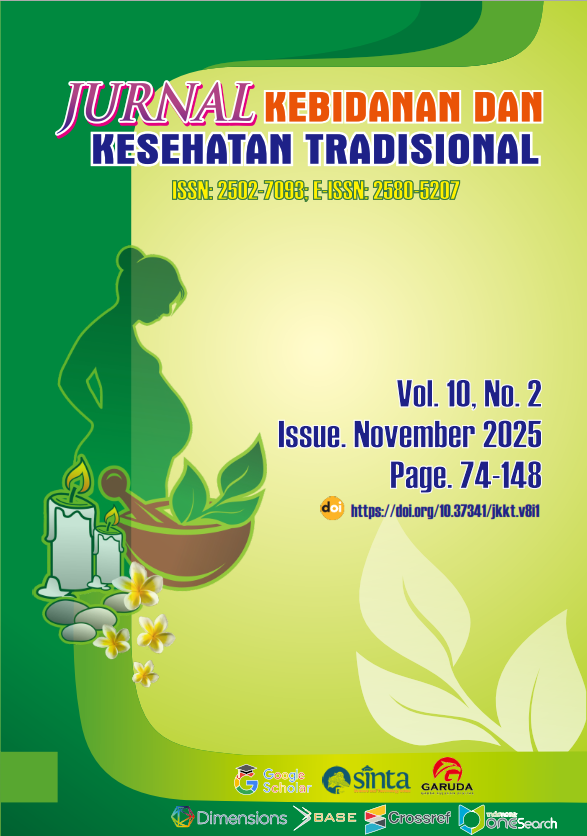Analysis Factors Related to Menstrual Disorders in Female Medical Students
Main Article Content
Abstract
Background: Every woman can experience various disorders of menstruation, ranging from amenorrhea, oligomenorrhea, polymenorrhoea, hypomenorrhea, hypermenorrhoea, and dysmenorrhoea. This study aimed to elucidate the factors related to menstrual disorders in female students of the faculty of medicine at Universitas Andalas.
Methods: The purpose of this case-control study is to determine factors that increase the likelihood of developing a disease by comparing a group of cases with a group of controls, focusing on their exposure status. The respondents to this study were teenagers aged 18-21 years. A sample of 108 female students was taken using consecutive sampling. Data collection from anthropometric measurements and questionnaires menarche age, The International Physical Activity Questionnaire (IPAQ), Food Frequencies Questionnaire (FFQ) and Pittsburg Sleep Quality Index (PSQI). The Chi-Square test was used to analyze the data.
Results: The result showed no significant relationship between menarche age (p-value 0.420), stress levels (p-value 0.406), and physical activity (p-value 0.348), with menstrual disorders. There was a relationship between nutritional status (p-value 0.001), sleep quality (p-value 0.002), and eating patterns (p-value 0.001) with menstrual disorders.
Conclusion: Diet is the factor most associated with menstrual disorders in female students, followed by sleep quality and nutritional status. The study recommends preventing menstrual disorders in female students by prioritising improvements in diet, sleep quality and nutritional status.
Article Details
References
Ani, M., Aji, S. P., Sari, I. N., Syarif, syastriani I. P., Patimah, M., Nisa, H. K., Kamila, A. U. I., Argaheni, N. B., Megasari, A. L., Rismawati, S., Susilawati, S., Pasundani, N. A., Haryani, L., & Saleh, U. K. (2022). Manajemen Kesehatan Menstrusi. PT Global Eksekutif Teknologi.
Anthon, C., Steinmann, M., Vidal, A., & Dhakal, C. (2024). Menstrual disorders in adolescence: Diagnostic and therapeutic challenges. Journal of Clinical Medicine, 13(24), 1–17. https://doi.org/10.3390/jcm13247668
Berliani, H., Desmawati, D., & Utama, B. I. (2023). Peran kadar hormon estrogen pada perempuan obesitas sebagai faktor terganggunya siklus menstruasi. Majalah Kedokteran Andalas, 46(2), 466–474.
Botutihe, F., Suntin, & Nur Hijrah Tiala. (2022). Aktivitas fisik dan tingkat stress dengan gangguan pola menstruasi. Retrieved November 9, 2025, from https://books.google.com/
Dahlan, S. (2021). Statistik untuk kedokteran dan kesehatan (6th Ed.). Epidemiologi Indonesia.
Demir, O., Sal, H., & Comba, C. (2021). Triangle of COVID, anxiety and menstrual cycle. Journal of Obsetrics and Gynaecology, 41(8). https://doi.org/10.1080/01443615.2021.1907562
Desmawati, D., Berliani, H., & Utama, B. I. (2024). Menstrual cycle variations observed in obese and normal-weight women. IJHN: Indonesian Journal of Human Nutrition Women, 44–52.
Dhar, S., Mondal, K. K., & Bhattacharjee, P. (2023). Influence of lifestyle factors with the outcome of menstrual disorders among adolescents and young women in West Bengal, India. Scientific Reports, 13(1), 1–11. https://doi.org/10.1038/s41598-023-35858-2
Martire, F. G., Giorgi, M., D’Abate, C., Colombi, I., Ginetti, A., Cannoni, A., Fedele, F., Exacoustos, C., Centini, G., Zupi, E., & Lazzeri, L. (2024). Deep infiltrating endometriosis in adolescence: Early diagnosis and possible prevention of disease progression. Journal of Clinical Medicine, 13(2), 1–18. https://doi.org/10.3390/jcm13020550
Mastuti. (2023). Buku ajar dasar ilmu gizi kesehatan masyarakat. PT. Sonpedia Publishing Indonesia.
Pratiwi, Harjanti, Oktiningrum, & Maharani. (2024). Mengenal menstruasi dan gangguannya. CV Jejak, Anggota IKAPI.
Saras Tresno. (2024). Progesteron hormon penting dalam keseimbangan tubuh wanita. Tiram Media.
Septiani, P., Minata, F., & Afrika, E. (2021). Analysis of factors associated with the incidence of menstrual disorders in women with mental disorders. Jurnal Kesmas Indonesia, 13 (1), 1–16.
Sherwood, l, and W. C. (2020). Human physiology: From cells to sytes: Vol. 4th ed. Nelson Education Ltd.
Sianipar, O., Bunawan, N. C., Almazini, P., Calista, N., Wulandari, P., Rovenska, N., E, R., Djuanda, Irene, Seno, A., & Suarthana, E. (2023). Prevalensi Gangguan Menstruasi dan Faktor-Faktor yang Berhubungan pada Mahasiswa di Kecamatan Pulo Gadung Jakarta Timur. Indonesian Journal of Midwivery (IJM), 59 (7), 1-6.
Siregar, H. S. N., Pane, A. H., Mustika, S. E., & Wardhani, K. (2022). hubungan kualitas tidur dengan siklus menstruasi pada mahasiswi FK UISU tahun 2021. Jurnal Kedokteran STM (Sains Dan Teknologi Medik), 5(2), 101–108. https://doi.org/10.30743/stm.v5i2.319
Taheri, R., Ardekani, F. M., Shahraki, H. R., Heidarzadeh-Esfahani, N., & Hajiahmadi, S. (2020). Nutritional status and anthropometric indices in relation to menstrual disorders: A cross-sectional study. Journal of Nutrition and Metabolism, 2020. https://doi.org/10.1155/2020/5980685
Thakur, H., Pareek, P., Sayyad, M. G., & Otiv, S. (2022). Association of premenstrual syndrome with adiposity and nutrient intake among young Indian women. International Journal of Women’s Health, 14, 665–675. https://doi.org/10.2147/IJWH.S359458
Wanggy, D. M., Ulfiana, E., & Suparmi, S. (2022). Hubungan antara status gizi, pola makan, aktifitas fisik dan stress dengan gangguan siklus menstruasi. Indonesian Journal of Midwivery (IJM), 5 (5), 1-12.

